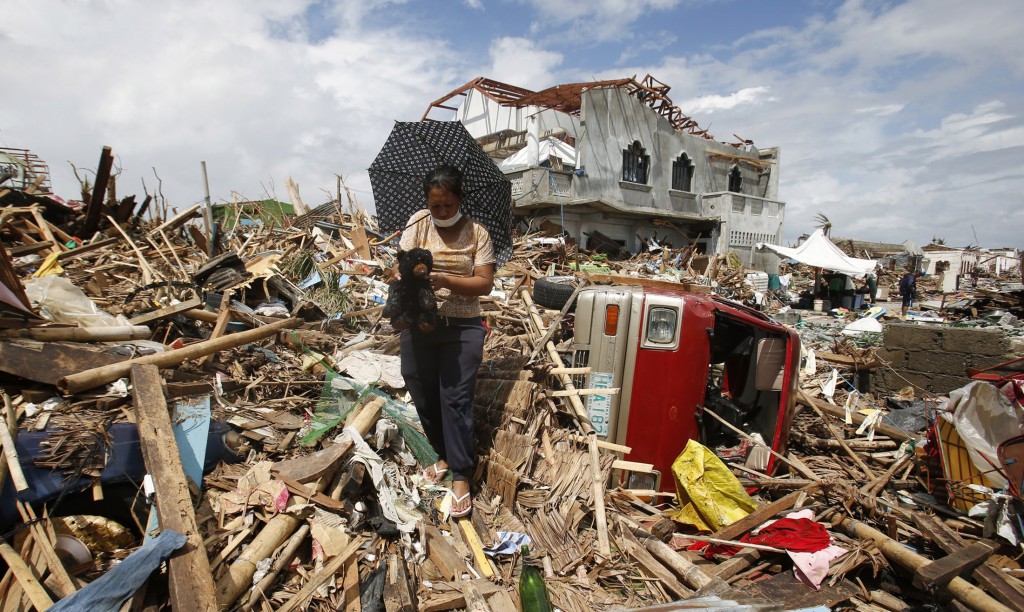
By Simone Orendain
Normally the trip from Maasin to Tacloban takes about three hours, but with the fallen trees and debris, getting aid there takes longer, said a priest from Southern Leyte province.
Father Harlem Gozo, director of the social action office for the Diocese of Maasin, had made two trips to the northern part of Leyte island, where the effects of Typhoon Haiyan were much worse.
Halfway to Tacloban, Father Gozo said, he saw coconut trees “somewhat beheaded” and concrete houses that looked quite sturdy if not for the trees the fell on them and split their roofs.
But as he traveled farther north, “That’s where the horrible sights start,” he told Catholic News Service in a telephone interview.
“You encounter corpses lying on the streets,” he said. “Imagine … the water just pushed down on them and they were caught unaware. And those who were in their houses, if they have a small house they drown inside. They pile up tables and chairs in order to step up so they would not get drowned. But if their house is small, their head is up to the ceiling and the water gets over and above them, that’s it. Others, when the water receded, they just got carried away by the current.”
Father Gozo said even if the survivors had food and it was stored at home, it got soaked with water, “so that after the storm, nothing to eat. Your house is devastated.”
The Diocese of Maasin in Southern Leyte was in good shape compared to the near-obliteration that happened in the northern half of the island in the central Philippines. Leyte is in the central part of the country where Super Typhoon Haiyan cut a path of destruction Nov. 8.
“In our diocese, generally, aside from trees falling down and electricity posts, there’s not much … damage,” said Father Gozo. On the rest of the island, “because of the challenges, the distance, the communication, the fuel, transportation and so on, the closest diocese that has communication is Maasin. All the rest are shut down.”
This meant no food or water for the needy in towns surrounding Tacloban, which has been the focus for much of the aid making its way into central Philippines since the storm hit.
Father Gozo said the families that he attended to were in shock and did not know what to do. With hungry stomachs and tenuous lines of communication, he said, they were dazed and unable to “think clearly.”
“We shed tears from deep within (over) the harrowing plight of our brothers and sisters,” he said in a text message after the phone call with CNS got dropped. “Our helping is our prayer of solidarity with their suffering, a share of the passion of Christ, that they are not alone. The Lord gives and the he also takes away, blessed be his name.”
The relief goods that started arriving in Tacloban on Nov. 9 had not gotten very far beyond the city limits because of the layers of debris that blocked passage ways, the lack of manpower to help expedite delivery and the hungry people who would stop the goods along the way.
Tacloban had most of the recorded deaths, which the government has placed at 2,300 nationwide by Nov. 14. Ninety percent of the houses in the city of 220,000 were either damaged or gone. And almost all of its first responders were as badly affected by the storm as the people they were supposed to help.
Apart from the challenge that was Tacloban, the country was dealing with more than 670,000 people left homeless by the storm. Multiple agencies of both civil society and government have been trying to get aid to more than half of them.
Areas that were not as badly affected by the storm pooled efforts to help out, especially in Tacloban and its surrounding vicinity.
Southern Leyte Vice Governor Mike Maamo said Nov. 14 that he was planning a third visit to the devastation the following day. He planned to take a team of 150 people to help secure safe passage for the relief convoys as they exited the distribution hub at Tacloban airport.
Maamo said a provincial disaster management council was particularly concerned with the far-flung towns cut off from aid. Council members created an “adopt a municipality” program to help these smaller communities.
Throughout the tragedy that he witnessed in Tacloban, Maamo, a self-described “devout Catholic,” said his faith never wavered.
“I really believe that God is helping us,” Maamo told CNS. “It’s not because you were affected by the typhoon that God is nowhere to be found. But you know, you should see to it that it’s not the material things that count, it’s your faith.
“I’ve been telling the families that are so desperate, ‘It’s not (what’s) in this world that counts. It is the life after death,” he said. “Maybe it’s at this point in time that we have to help each other, even if we lost some members of our family.” – CNS